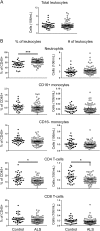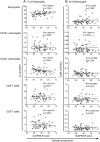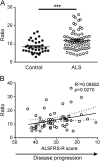Increased ratio of circulating neutrophils to monocytes in amyotrophic lateral sclerosis
- PMID: 27308304
- PMCID: PMC4897983
- DOI: 10.1212/NXI.0000000000000242
Increased ratio of circulating neutrophils to monocytes in amyotrophic lateral sclerosis
Abstract
Objective: To elucidate amyotrophic lateral sclerosis (ALS) biomarkers and potential mechanisms of disease, we measured immune cell populations in whole blood from a large cohort of patients with ALS.
Methods: Leukocytes were isolated from the blood of 44 control patients and 90 patients with ALS. The percentages and total numbers of each cell population were analyzed using flow cytometry and matched with patient ALS Functional Rating Scale-Revised (ALSFRS-R) score to correlate leukocyte metrics with disease progression.
Results: We show a significant increase in the percentage of neutrophils and a significant decrease in the percentage of CD4 T cells and CD16(-) monocytes in the blood of patients with ALS compared to controls; however, only CD16(-) monocyte levels correlated with disease progression. We also examined the monocyte surface expression of CCRL2 and CCR3; CD16(-) monocytes displayed decreased percentages and total numbers expressing CCR3, but these numbers did not correlate with ALSFRS-R score. We found that combining multiple disease metrics yielded the most accurate predictor of disease progression: the ratio of neutrophils to CD16(-) monocytes (N:M ratio) is significantly increased in patients with ALS and better correlates with disease progression than any other single metric.
Conclusions: These observations implicate neutrophils and monocytes as important factors in late disease progression.
Figures




References
-
- Murdock BJ, Bender DE, Segal BM, Feldman EL. The dual roles of immunity in ALS: injury overrides protection. Neurobiol Dis 2015;77:1–12. - PubMed
-
- Brouwer N, Zuurman MW, Wei T, Ransohoff RM, Boddeke HW, Biber K. Induction of glial L-CCR mRNA expression in spinal cord and brain in experimental autoimmune encephalomyelitis. Glia 2004;46:84–94. - PubMed
LinkOut - more resources
Full Text Sources
Other Literature Sources
Research Materials
Miscellaneous
